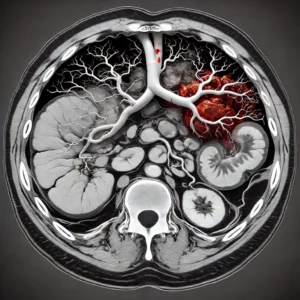Mesenteric Vein Clot
A mesenteric vein clot is part of a group of conditions also known as “clots in unusual locations”. The common location for “usual” clots are the arm and leg veins and the lung arteries. A blood clot in the arm or leg veins is known as a deep vein thrombosis. A clot in the lung arteries is known as a pulmonary embolism. Both are considered venous clots, because the lung arteries drain back into the heart.

Symptoms of Mesenteric Vein Clots
A patient who develops a mesenteric vein clot will usually suffer from sudden abdominal pain. The pain will usually be “epigastric”. This means that the pain will usually be in the upper, middle, part of the abdomen, just below the chest bone. Some patients will develop diffuse abdominal pain.
Some patients will develop more significant symptoms. If the clot is significant, it may block the return of blood flow from the intestines. If this happens, the intestines may swell and stop functioning. In severe cases, the intestines will develop gangrene. This is a life-threatening condition.
It is important to note, that mesenteric vein thrombosis is different from chronic mesenteric ischemia. In chronic mesenteric ischemia, the blockage is usually in a mesenteric artery. There is usually buildup of plaque due to atherosclerosis. But, still, some patients will suffer from chronic abdominal pain after a mesenteric vein clot.
Causes
A mesenteric vein clot is considered “unusual”. This means that when it occurs, you should think about underlying causes. Typical causes to think about include at least the following:
- Hypercoagulable conditions – These are hereditary or acquired conditions that are associated with increased clotting. Classic examples of conditions to think about in cases of a mesenteric vein clot include prothrombin gene mutation and the JAK2 mutation. Test for thrombophilia in cases of mesenteric vein clots that do not have another explanation.
- Cancer – Look for cancer if a patient has a mesenteric vein clot.
- Trauma – If the mesenteric vein is injured, or if there is inflammation near that area, then a clot may form inside the vein.
Treatment of Mesenteric Vein Clots
Treatment starts with blood thinners (anticoagulation) and stabilization. Stabilization means that some patients need to spend time in an intensive care unit for observation, in case they deteriorate and require more sophisticated therapies.
Sicker patients may need thrombolytics. These medicines are known as “clot busting medications”. Obviously, they are not as safe as blood thinners. A patient who is receiving a thrombolytic agent is at risk for bleeding. On the other hand, if the clot is jeopardizing the intestines, then sometimes there is no way around that treatment.
The literature on mesenteric vein clots is skewed toward treatment with thrombolytics. But it has been our experience that many patients do not require this type of therapy.
Still, sometimes patients need procedures or surgery. For instance, some patients will need a catheter to be placed inside the blocked vein, either to administer thrombolysis or to clean out the clot. Next, if parts of the intestines have died and developed gangrene, then a surgeon will take the patient to the operating room for emergent surgery.

